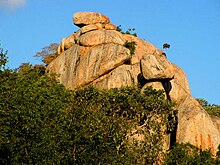Kopje
Kopje s ( Afrikaans for "small heads"), sometimes also called "island mountains", are often head-high, but also up to one hundred meters high, granite rocks from which the constant temperature change from day and night as well as the wind have formed the most diverse structures.
They have different functions than the surrounding grasslands or forests. In the case of grass fires, they often represent a natural barrier. With their many crevices, holes and caves, they also offer smaller animals shelter and larger predators such as lions and cheetahs also serve as vantage points.
Occurrence
Kopjes occur from East to South Africa, especially in the Serengeti of Tanzania .
geology
Serengeti
The Serengeti is stocky from a thick layer of very old, metamorphic rock that formed late in the Precambrian when a giant bubble of liquid granite made its way from the liquid layers below the earth's crust into the Tanganyika shield. This layer was covered with deposits of volcanic rock and ash, also from the eruption of the volcano of the Ngorongoro crater. Since these softer rocks are now locally weathered, the irregular granite layer in the form of the Kopjes is partly exposed today. Because of the wind erosion, many Kopjes are predominantly round or have a round granite block on the top as a capstone.
Flora and fauna
Around the Kopjes and in their immediate vicinity, due to the high groundwater level, a comparatively large number of different plant species grow that are missing in the grasslands. Specially adapted animal species therefore also live on the Kopjes, which have settled there because of the plants (and other animals) typical of the location as a source of food and because of the hiding places and opportunities for viewing. These include many types of insects, birds, but also lizards, snakes and smaller mammals such as mice and large predators such as. B. Lions. These, like cheetahs, like to hide their young on the Kopjes. Another type of mammal that has been adapted to this is the hyrax that live on the Kopjes. They feed exclusively on the grasses and herbs on the Kopjes and its surroundings. Especially at night you can hear their piercing calls. Since the animals also use shared “toilets”, they can also be tracked down by the fact that the granite was discolored brightly by the high levels of uric acid in these areas. The very shy klipspringer (small antelopes with graceful hooves) also mainly stay on the Kopjes.
Web links
- Discover the Serengeti - Kopjes. ( Memento from April 15, 2013 in the web archive archive.today ) Serengeti.org


